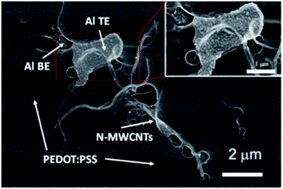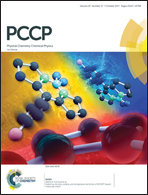Study of the presence of spherical deformations on the Al top electrode due to electroforming in rewritable organic resistive memories†
Abstract
Physical deformations are observed at the top electrodes during the electroforming process in Al/PEDOT:PSS + nitrogen doped multiwalled carbon nanotube (N-MWCNTs)/Al rewritable resistive memory devices. These physical deformations arise from electrochemical reactions, i.e., a reduction reaction in the native Al oxide layer, which are similar to those reported in TiO2-based resistive memory devices. These memory devices are electroformed at the ON state using an ∼−2 V pulse or at the OFF state using an ∼3 V pulse. These processes are current-controlled; a minimum compliance current is necessary to obtain the electroforming of the device, generally between 5 to 10 mA. SEM and AFM micrographs show the presence of spherical deformations at the top electrode due to O2 gas formation generated by the reduction in the native AlOx layer during the electroformation, with a diameter of ∼7 micrometres for positive voltage or a smaller diameter of ∼3 micrometres for negative voltage. After top-electrode delamination, circular craters are found in the active layer in the vicinity of the N-MWCNTs, which only occurs when a negative voltage is used in the electroformation, indicating that film damage is induced by oxygen bubbles created at the bottom electrode/polymeric film interface.



 Please wait while we load your content...
Please wait while we load your content...